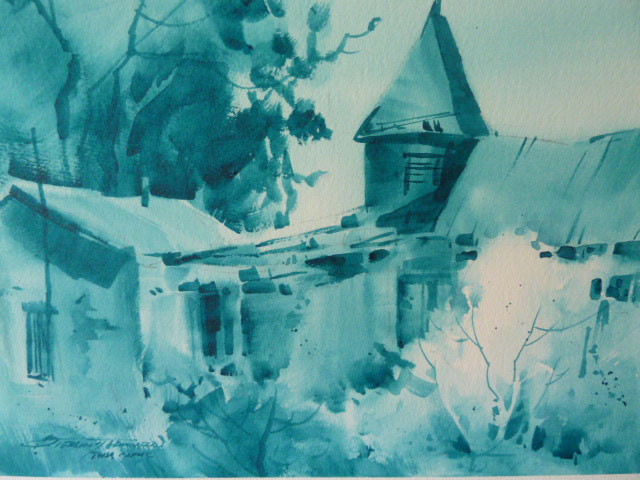Teaching and Learning and Caring Blog
EL PASO — Last week I was reminded of my first watercolor class. Hilda Rosenfeld painted exquisite flowers and was my teacher in a continuing education class at UTEP. Our first assignment was to make twelve squares on a piece of paper and use a tube of ultramarine blue paint to make each square lighter than the last. My first thought was how unexciting this exercise would be. At the end we would have twelve squares ranging from pure pigment to barely a hint of color.
Today I am showing you how this works with a tube of alizarin red and 24 squares. It is an exercise in values — values of light and dark that is — not morality. It turned out to be a fabulous class and, from then on, I painted when I could. Now that I am retired, I can in theory paint whenever I feel like it. Last week I took another class in Cloudcroft with a man named Sterling Edwards, an ex-cop from North Carolina, who had a similar lesson for us. We saw two entire paintings that used only one color, one blue and the other purple. We can talk about the colors later.

Monochromatic values demonstration by Sterling Edwards. (Courtesy of Ruby Cochrell)
After the first class, I thought about this lesson in a different context. After all, I was a sociology, not an art, professor. I thought about language and vocabulary, starting with colors. Blue, we say blue. It could be navy blue, robin egg blue, sky blue, ocean blue, several different colors, but we say blue. Here in the southwest, we usually give turquoise its own name, a small concession.
We also speak of our thoughts and feelings without much subtlety. We say we feel sad (also a color, blue) or mad (seeing red). It is up to someone else to fill in the details we are missing. Then there is the new word ending “-ish.” Is it a suffix or a slang way of saying we haven’t quite said what we meant? And is it on purpose that we don’t say what we mean?
“Good morning.” Is it? “How are you today?” “Fine, thank you.” Trust me you don’t really want to know, and even though I say I’m fine, I’m not. Or, trust me I am just being polite, I really don’t give a damn. The research methods book I used showed in dialogue how it was likely that we would completely unnerve people by telling them the truth when they really didn’t want to know.
Yet both art and science are about telling the truth, even when it is uncomfortable, even if no one asks. And we need language or color or mathematics to tell the truth. There is a poet from New Mexico, Jimmy Santiago Baca. He spent quite a bit of time in prison and wrote an autobiographical book about his childhood and prison years called A Place to Stand. In it, he describes the process of finally learning to read … after he was in prison, becoming a poet, the place of language in his current life, and the absence of it in his early years. He suggested that not knowing words to describe emotions can lead to rage, and that rage almost always leads to violence. He knows it did in him, in his brother, in his father.
As we have glorified physical strength and even violence in our culture, we have also denigrated language and art as sissy subjects, not tellers of truth. Books, who needs them? Art, why would you ever spend money on that? And science is only masculine in so far as it is applied… and the best applications are of course, military. Spare us the details of the mathematical equations. We are busy out riding our quads or pumping them at the gym.
My students will remember me bringing both the squares of color and the passages from the Baca book when we discussed these topics. And my vote will always go to seven types of ambiguity (look it up), twenty four shades of red, a subscription to the word of the day, and most of all, to telling the truth.

24 shades of red. (Courtesy of Josie Jimarez Howard)

